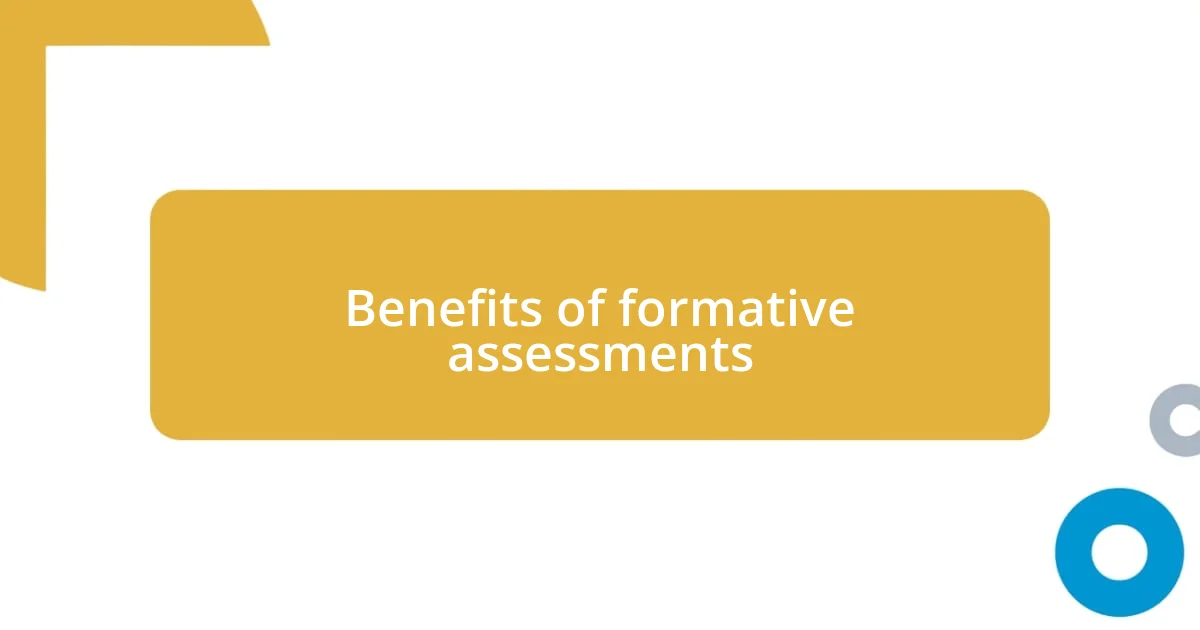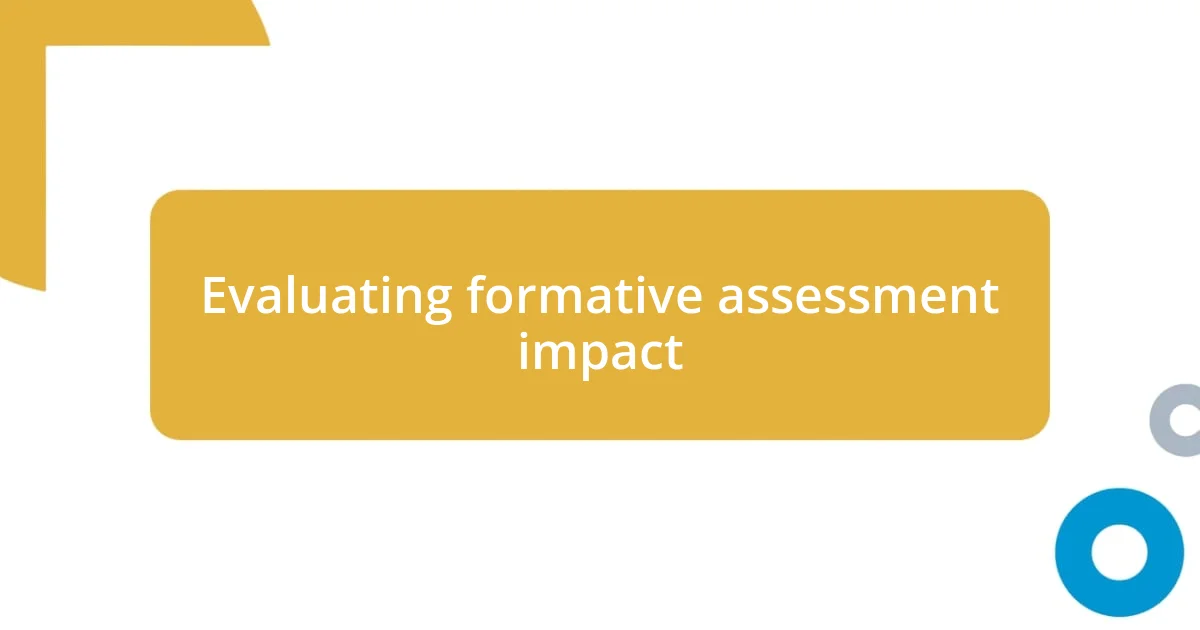Key takeaways:
- Formative assessments empower educators by revealing students’ understanding and misconceptions, fostering a growth mindset and continuous learning rather than solely focusing on grades.
- Effective implementation strategies include technology integration for engagement, regular check-ins to assess understanding dynamically, and peer assessments to enhance collaborative learning.
- Future trends in formative assessments involve utilizing technology for personalized feedback, incorporating student voice in assessment design, and emphasizing collaborative peer review processes.

Understanding formative assessments
Formative assessments are tools that help educators understand how students are grasping a concept while learning is still happening. I remember when I first implemented these assessments in my classroom; I felt a sense of empowerment. It was eye-opening to see where my students were struggling and where they thrived. How often do we think we know where a student stands, only to be surprised by their misconceptions?
I have found that formative assessments are not just about grades; they’re about fostering a growth mindset. Once, after a quick quiz on a challenging topic, one student shared how relieved they felt to see their gaps in understanding laid out clearly. That moment reinforced my belief that these assessments should provide comfort, not pressure. Think about it: wouldn’t you prefer to know where you need to focus your efforts rather than wait for a big test to reveal your weaknesses?
These assessments can take many forms, from quick polls to interactive discussions. I often use exit tickets to gauge my students’ grasp of the day’s lesson, and it creates a lively back-and-forth. It’s not just data; it’s a conversation that can guide my teaching. Isn’t it fascinating how a simple question can spark deeper insights and lead to significant changes in our approach?

Benefits of formative assessments
When I think about the benefits of formative assessments, what comes to mind is the immediate feedback loop they create. For instance, during a recent project, I asked my students to submit draft versions. The insights I gained not only helped me to provide tailored guidance but also reassured the students that they were on the right track. This engagement often led them to feel more connected to the learning process, knowing they could adjust and improve their work before the final submission.
Here are some specific benefits I’ve noticed with formative assessments:
- Targeted Instruction: They allow me to tailor my lesson plans based on student needs.
- Student Engagement: Students feel more involved and invested in their learning journey.
- Growth Mindset: They foster a culture where mistakes are viewed as opportunities for learning rather than failures.
- Immediate Adjustments: They offer real-time insights that help me pivot my teaching strategies on the fly.
- Building Confidence: When students see their progress over time, it boosts their confidence and motivation to learn.
I can vividly recall a moment when a student told me they felt “seen” after a formative assessment helped to clarify their learning gaps. That connection was powerful and reminded me why I value these assessments in the classroom.

Key strategies for implementation
Implementing formative assessments requires strategic planning and thoughtful execution. One effective strategy I’ve employed is integrating technology, such as interactive quizzes through platforms like Kahoot or Google Forms. I remember the excitement in the classroom when I used these tools for a math review; it transformed a traditional assessment into a fun game where my students actively participated. This approach not only made the learning enjoyable but also provided instant feedback that I could analyze right away.
Moreover, I’ve found that embedding regular check-ins during lessons is crucial. For example, I often pause to ask students to reflect on what they’ve learned so far, which helps me gauge their understanding and adjust my teaching on the spot. Each time I do this, it feels invigorating to witness my students engage in dialogue about their learning—sometimes their insights surprise me in the best ways. This two-way communication builds a stronger classroom community and allows students to feel a sense of ownership over their learning process.
Lastly, I encourage peer assessments as a way for students to learn from each other. I’ve set up small group activities where they exchange feedback on each other’s work. It’s rewarding to see their confidence blossom as they articulate constructive critiques. One student once told me that reading a peer’s perspective helped her understand the material in a way that my explanations hadn’t. This realization reinforced for me the power of collaborative learning and how formative assessments can flourish in an environment of shared knowledge.
| Strategy | Description |
|---|---|
| Technology Integration | Using platforms like Kahoot for interactive quizzes creates an engaging learning environment with instant feedback. |
| Regular Check-Ins | Pausing during lessons to discuss concepts fosters student dialogue and helps assess understanding dynamically. |
| Peer Assessments | Encouraging students to give and receive feedback among peers enhances their understanding and confidence in the subject matter. |

Effective feedback techniques
Effective feedback is an art, and I’ve found that being genuinely specific transforms the experience for my students. Instead of just saying, “Great job!”, I dive into what exactly impressed me about their work—perhaps highlighting how they articulated their argument or used evidence effectively. This clarity not only validates their effort but also guides them on how to replicate that success in future tasks. Have you ever noticed how details in feedback can ignite a spark of motivation? It’s profoundly rewarding to witness that shift.
Another technique that’s served me well is the use of “feedforward” instead of just feedback. While feedback looks back at what has been done, feedforward emphasizes what to do next. I often tell my students to think of it as a roadmap for their learning journey. For instance, after grading an assignment, I’ll suggest, “Next time, consider organizing your points more clearly, and remember to use transition phrases to connect your ideas.” This forward-looking approach not only empowers students but allows them to see learning as a continuous process rather than a series of isolated events.
Lastly, I’ve experienced firsthand the power of informal, ongoing conversations about progress. I remember one student who, after receiving feedback, spent time chatting with me about her learning struggles. She said it was eye-opening to realize she wasn’t alone. Those moments of connection—where feedback evolves into a dialogue—can change a student’s perspective entirely. Have you tried fostering those kinds of relationships? When students feel they can come to you, it builds trust and encourages them to take risks in their learning.

Common challenges and solutions
One challenge I often face with formative assessments is the inconsistency in student engagement. There have been times when I introduced an interactive tool, and some students simply wouldn’t participate. I realized that not all students are comfortable with technology or may feel shy in front of their peers. To address this, I started offering alternative methods for engagement, like silent reflections or written responses. This way, every student has the chance to express their understanding in a manner that suits them best.
Another issue I’ve encountered is time management during class assessments. Initially, I felt pressured to cover all the material, which led to rushed assessments and unclear feedback. It was a wake-up call when students would ask for clarification on tasks I thought they understood. To solve this, I’ve learned to allocate specific time slots for formative assessments and communicate that clearly to my students. This shift not only gives them time to think and reflect but also allows me to interpret their responses more effectively, reinforcing the idea that understanding takes time.
A common struggle with peer assessments is the hesitation on some students’ parts to give honest feedback. I vividly recall a group project where one student was really reluctant to critique their peers, fearing it might hurt feelings. I empathized with her and encouraged open discussions about the purpose of constructive criticism. By framing feedback as a tool for growth rather than a personal critique, I saw her confidence blossom. Now, they actively support one another, which transforms the atmosphere in the classroom into one that values improvement and collaboration. Isn’t it incredible how a slight shift in perspective can unlock so much potential?

Evaluating formative assessment impact
Evaluating the impact of formative assessments requires delving beyond grades. I recall a semester when I implemented quick exit tickets at the end of class. Initially, I only looked at them to gauge understanding, but I soon realized their true value lay in pinpointing common misconceptions. A single glance at those responses shifted my entire approach to following lessons. Have you ever noticed a simple tool reshaping your instructional strategies?
Moreover, I’ve found that analyzing the frequency of student participation during formative assessments unveils deeper insights. One year, I tracked engagement levels meticulously and discovered that certain students thrived in group settings while others preferred one-on-one interactions. This awareness prompted me to mix up my instructional strategies, ensuring all voices were heard. It’s amazing how this tailoring not only enhanced learning but also fostered a sense of belonging among my students—something every learner craves, right?
Finally, I make it a point to solicit feedback on the assessments themselves. During a reflective session, one student candidly shared that he found our quizzes too stressful. Instead of dismissing his feelings, I took it to heart, and we collaborated on adjusting the format. This small adjustment led to greater comfort and participation—counting both his and his classmates’ voices in this evaluation process was a game-changer. Have you ever had moments where student feedback transformed your teaching approach? It’s in these moments that I truly grasp the impact of formative assessments.

Future trends in formative assessments
As I look ahead to the future of formative assessments, I can’t help but think about the increasing role of technology. It’s fascinating how tools like AI can provide real-time feedback tailored to each student’s needs. Recently, I experimented with a platform that utilized adaptive learning, and it was remarkable to see how students thrived when they received personalized challenges. Did you ever think about how technology could transform the way we evaluate learning?
Another trend I’m excited about is the integration of student voice in shaping assessments. After conducting a brainstorming session on what methods they felt most comfortable with, I was blown away by their creativity. One student suggested using artistic expressions alongside written reflections. I never would have considered that approach without their input! How empowering is it to give learners the reins in their educational journey?
Finally, I see a shift towards collaborative formative assessments, where peer feedback becomes a core component. During a recent project, I organized a peer review session, and witnessing the excitement as students embraced the role of both learner and teacher was invigorating. They shared insights and celebrated each other’s strengths, creating a supportive learning community. It made me wonder—what if we embrace this model fully, harnessing our students’ perspectives to enrich the assessment process even further?












